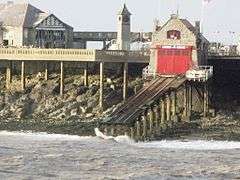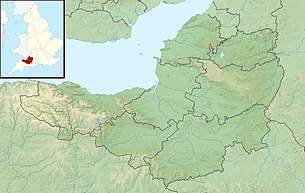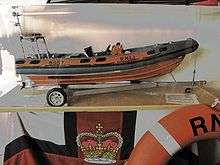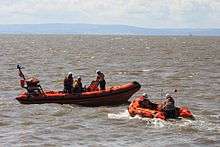Weston-super-Mare Lifeboat Station
Weston-super-Mare Lifeboat Station is a lifeboat station at Weston-super-Mare in Somerset, England.[1] For more than 100 years it was situated on Birnbeck Island and but is now in a temporary building at Knightstone Harbour until a new lifeboat station can be built near by. Iit is operated by the Royal National Lifeboat Institution (RNLI). The first lifeboat was stationed in the town in 1882 and since 1969 it has only operated inshore lifeboats (ILBs), currently a B-class (Atlantic 75) and a smaller D-class (IB1).
| Weston-super-Mare Lifeboat Station | |
|---|---|
 The lifeboat station at Birnbeck which was used from 1902 until 2014 | |
 Weston-super-Mare shown within Somerset | |
| General information | |
| Type | RNLI Lifeboat Station |
| Location | Knightstone Harbour, BS23 2BE |
| Country | United Kingdom |
| Coordinates | 51.352246°N 2.988129°W |
| Opened | 1882 |
| Owner | Royal National Lifeboat Institution |
History
Birnbeck Island

The Bristol Channel has an extreme tidal range which made it difficult for the RNLI to find a site from which a lifeboat could be easily launched at all states of the tide. In 1882 they installed davits on the pier linking the mainland with Birnbeck Island, from which the town's first lifeboat to be launched like a ship's lifeboat into the water below, even at low tide.[2]
A 100 feet (30 m) slipway was brought into use in 1889, along with a new lifeboat house on the north east side of the island. This coincided with the delivery of a new lifeboat, as did the opening of the next lifeboat house in 1902. This was on the south east side of the island and required the construction of the longest lifeboat slipway in England, measuring 368 feet (112 m).[2][3]
On 12 March 1969 the Weston-super-Mare lifeboat, the Calouste Gulbenkian, was away for servicing when the temporary lifeboat, the Rachel and Mary Evans, broke away from a mooring off the pier and was wrecked on Birnbeck Island.[4] Since this time Weston-super-Mare has only operated inshore lifeboats (ILBs), although ILBs have been stationed here since 1966.[4]
A heavy storm in 1991 damaged a large part of the slipway. Repairs were undertaken by following summer, but in the meantime the two ILBs were moored afloat in the River Axe at Uphill. In 2007 the poor condition of the slipway again forced its closure. The launch site moved to an old slipway on the north side of the island. The crews continued to use the 1889 boathouse[5] but the lifeboats were kept on their launch trolleys on Birnbeck Island outside the boathouse. In April 2011 a new "temporary" boathouse was erected to give them cover. This cost £70,000 but can be removed once permanent facilities can be provided again and then reused elsewhere.[6]
Knightstone
The pier has been in poor condition for many years and has been closed to the public since 1994. The RNLI has laid boards on top of it to provide a safer access route for their volunteers but since December 2013 a portable building has been situated adjacent to the Marine Lake and the lifeboat can be launched using the slipway into Knightstone Harbour. This is not possible, however, at low tide. The larger lifeboat remained in the 'temporary' building on Birnbeck Pier for a while from which it could be launched when required at any state of the tide but only "when there is a significant risk to life".[7] It has since joined the smaller D-class boat at Knightstone. In 2015 the RNLI announced that it would seek planning permission for a permanent lifeboat station at Knightstone Harbour along with deep-water anchorage at Anchor Head.[8]
However it was revealed in 2020 that the RNLI could potentially take ownership of Birnbeck, which is subject to a compulsory purchase order by the local council.[9]
Services
The first lifeboat at Weston-super-Mare was on station for seven years but it was only involved in two rescues, one of which involved taking 40 passengers off the SS Welsh Prince which got into difficulties after leaving Birnbeck Pier on 22 September 1884.[2] In all, the pulling and sailing lifeboats that were stationed at Weston-super-Mare during the 51 years from 1882 to 1933 were only called out on 12 services and rescued 55 people. The motor lifeboats over the next 36 years were called out 104 times and rescued 89 people.[10]
In common with other lifeboat stations, the number of service calls has increased significantly since the 1960s due to the rise in leisure craft and swimmers. A-504, the first large ILB, rescued 65 people in 172 services during its 13 years at Weston-super-Mare; the other ILBs have now made well over 1,000 service launches.[10] Weston-super-Mare is the busiest RNLI station on the south side of the Bristol Channel. In 2010 it was called into action on 47 occasions, rescuing 27 people and also a dog which had fallen down a cliff;[11] in 2011 there were 42 launches totalling 133 hours at sea and resulting in the rescue of 19 people.[12]
Late in the evening of 13 September 1975 ILB A-504 was launched info a Force 9 gale in response to a report of red flares being seen off Brean Down, the promontory on the south side of Weston Bay. The crew found a motor boat on rocks in a cove below Brean Down, with people both in the water and on the cliff above the boat. An anchor was dropped and the lifeboat used the tide to bring it as close as possible to the shore, the motors being lifted out of the water to allow it to get as close in shore as possible. The people were then hauled through the water attached to a safety line. Helmsman Julian Morris was awarded an RNLI Bronze Medal for his outstanding seamanship, great skill and tremendous courage.[13]
On the afternoon of 20 July 1986 Helmsman Morris took Weston Centenary to Brean Down to rescue two young boys who had been trapped by the tide, but he could only get to within 40 yards (37 m) of the shore. Lifeboatman Richard Spindler volunteered to swim through the 5 feet (1.5 m) high surf several times to take lifejackets to the boys and bring them back to the lifeboat. For his bravery he was awarded the RNLI's 'Thanks on Velum'.[14]
Area of operation
The Atlantic 75 can go out in Force 7 winds (Force 6 at night) and can operate at up to 32 knots (59 km/h) for 2½ hours.[15] Adjacent ILBs are stationed at the RNLI's Burnham-on-Sea Lifeboat Station to the south, and the independent station at Portishead to the north. If a larger all weather boat is needed in the area it comes across the Bristol Channel from Barry Dock.[16]
Fleet
'ON' is the RNLI's sequential Official Number; 'Op. No.' is the operational number painted onto the boat.
All weather lifeboats
| Dates in service | Class | ON | Op. No. | Name | Power | Notes |
|---|---|---|---|---|---|---|
| 1882–1889 | Peake-class | ON 259 | William James Holt | 8 oars[2] | [Note 1] | |
| 1889–1903 | Peake-class | ON 249 | William James Holt | 12 oars[2][17] | ||
| 1903–1933 | Watson-class (Pulling & Sailing) | ON 488 | Colonel Stock | 12 oars[2][18] | [Note 2] | |
| 1933–1962 | Liverpool-class | ON 765 | Fifi and Charles | 35 hp Petrol engine[19][20] | [Note 3] | |
| 1962–1969 | Oakley-class | ON 961 | 37-03 | Calouste Gulbenkian | 2 x 43 hp Diesel engines[21][22] | [Note 4] |
Inshore lifeboats



A- and B-class
| Dates in service | Class | Op. No. | Name | Comments |
|---|---|---|---|---|
| 1970–1983 | McLauchlan-class | A-504[Note 5] | Unnamed[23][24] | [Note 6] |
| 1983–2001 | Atlantic 21-class | B-557 | Weston Centenary[25][26] | |
| 2001–2005 | Atlantic 75-class | B-769 | Coventry and Warwickshire[27] | [Note 7] |
| 2005–2007 | Atlantic 75-class | B-701 | Gordon England[28] | |
| 2007–2008 | Atlantic 75-class | B-736 | Toshiba Wave Warrior[28] | |
| 2008–2018 | Atlantic 75-class | B-769 | Coventry and Warwickshire[27] | |
| 2018–2019 | Atlantic 75-class | B-787 | Paul Alexander | |
| 2019–present | Atlantic 75-class | B-794 | Joan Bate[29] |
D-class
| Dates in service | Class | Op. No. | Name | Comments |
|---|---|---|---|---|
| 1966–1968 | D-class (RFD PB16) | D-83 | Unnamed[30][31] | |
| 1968–1972 | D-class (RFD PB16) | D-74 | Unnamed[30][31] | |
| 1969–1970 | D-class (RFD PB16) | D-47 | Unnamed[32][31] | |
| 1973–1981 | D-class (RFD PB16) | D-170 | Unnamed[33][34] | |
| 1981–1989 | D-class (Zodiac III) | D-282 | Unnamed[35][36] | |
| 1989–1998 | D-class (EA16) | D-387 | Boto-X 87[37][38] | |
| 1998–2008 | D-class (EA16) | D-537 | Faith[39][40] | |
| 2007–2007 | D-class (EA16) | D-570 | Joan and Ted Wiseman 50[40] | |
| 2008–2018 | D-class (IB1) | D-696 | Anna Stock[41] | |
| 2018-present | D-class (IB1) | D-832 | Adrian Beaumont[42] |
Notes
- The 1882 William James Holt was transferred to Southend when it was replaced by the second, larger, boat with that name. It was renamed Boys of England and Edwin J. Brett but was withdrawn in 1891.
- Colonel Stock was sold and converted to a yacht, last reported on the River Thames in 1996 carrying the name Tova.
- Fifi and Charles was sold and converted to a yacht, last reported at Redon, France, in 2008 carrying the name Wyvern.
- Calouste Gulbenkian was later part of the RNLI reserve fleet until becoming the New Quay Lifeboat in 1990. It was withdrawn the following year and is now in Donaghadee for restoration.
- McLauchlan-class lifeboats were originally given Operational Numbers in the ALB series. The one stationed at Weston-super-Mare A-504 carried number 18-004 until 1973 when it became A-504 in the ILB series.
- 18-004 was the first production member of the McLachlan class. It was displayed at the Earls Court Boat Show in January 1970 before taking up station at Weston-super-Mare on 9 May. It is now preserved in the Lifeboat Museum at Chatham Historic Dockyard.
- Coventry and Warwickshire saw service at Plymouth Lifeboat Station in 2005 and 2006 and then became part of the RNLI relief fleet until its return to Weston-super-Mare in 2008.
See also
References
- "Weston-super-Mare Lifeboat Station – RNLI website". Home page of the Weston-super-Mare station. RNLI. Retrieved 10 April 2014.
- Morris 2000, pp. 1-2.
- Terrell, Stan. Birnbeck Pier, a short history. North Somerset Museum Service. p. 13. ISBN 0-901104-10-8.
- Morris 2000, pp. 6-8.
- "Weston-super-Mare History". Royal National Lifeboat Institution. Retrieved 27 April 2012.
- "Temporary shelter for Weston-super-Mare RNLI lifeboats". Royal National Lifeboat Institution. 11 April 2011. Retrieved 25 April 2011.
- "New home for Weston-super-Mare's RNLI lifeboat". BBC. Retrieved 5 December 2014.
- "New site found for Weston-super-Mare's RNLI lifeboat". BBC. Retrieved 22 January 2015.
- "Lifeboat station could move back to Birnbeck Pier". BBC News. 26 June 2020. Retrieved 26 June 2020.
- Morris 2000, p. 46.
- "47 launches for Weston-Super-Mare RNLI Lifeboat in 2010". RNLI. 26 January 2011. Retrieved 25 March 2011.
- "Weston RNLI volunteers man busiest lifeboat station on south Bristol Channel". RNLI. 8 February 2012. Retrieved 25 April 2012.
- Morris 2000, pp. 12-13.
- Morris 2000, p. 35.
- "Atlantic 75 and 85 (B Class)". RNLI. Retrieved 2 December 2010.
- Denton 2010, p. 68.
- Denton 2010, p. 6.
- Denton 2010, p. 12.
- Morris 2000, pp. 2-6.
- Denton 2010, pp. 22-23.
- Morris 2000, p. 6.
- Denton 2010, pp. 30-36.
- Morris 2000, pp. 8-33.
- Denton 2010, p. 43.
- Morris 2000, pp. 32-45.
- Denton 2010, p. 50.
- Denton 2010, p. 52.
- Denton 2010, p. 51.
- "The Lifeboats". RNLI Weston-super-Mare. Retrieved 29 March 2020.
- Morris 2000, p. 7.
- Denton 2010, p. 54.
- Morris 2000, pp. 8-9.
- Morris 2000, pp. 9-32.
- Denton 2010, p. 56.
- Morris 2000, pp. 32-36.
- Denton 2010, p. 58.
- Morris 2000, pp. 36-41.
- Denton 2010, p. 59.
- Morris 2000, pp. 41-45.
- Denton 2010, p. 62.
- Denton 2010, p. 64.
- "The volunteers of Weston RNLI give thanks to the family who following a tragic crash made a magnificent donation". RNLI Weston-super-Mare. Retrieved 8 July 2019.
Bibliography
- Denton, Tony (2010). Handbook 2010. Shrewsbury: Lifeboat Enthusiasts Society.CS1 maint: ref=harv (link)
- Morris, Jeff (2000). The Story of the Weston-super-Mare Lifeboats. Coventry: Lifeboat Enthusiast's Society.CS1 maint: ref=harv (link)
- Crockford-Hawley, John (2015). Weston-super-Mare Lifeboat Station. Poole: RNLI.
External links
| Wikimedia Commons has media related to Weston-super-Mare Lifeboat Station. |